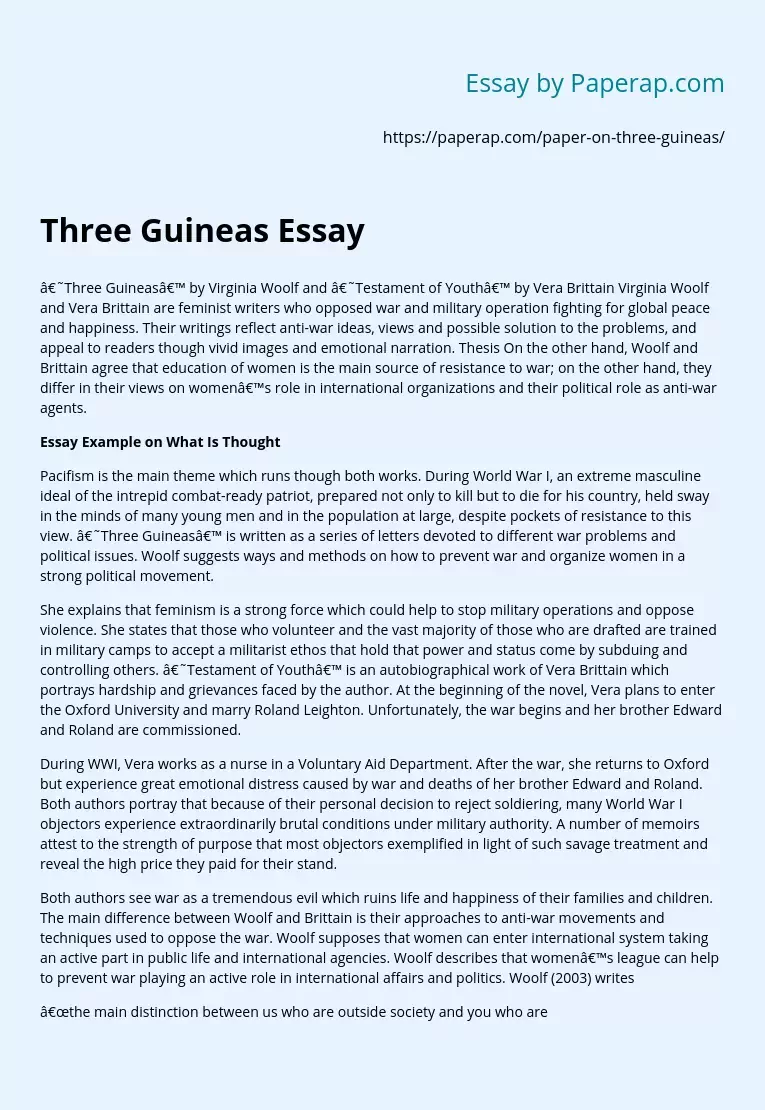Three Guineas Essay
‘Three Guineas’ by Virginia Woolf and ‘Testament of Youth’ by Vera Brittain Virginia Woolf and Vera Brittain are feminist writers who opposed war and military operation fighting for global peace and happiness. Their writings reflect anti-war ideas, views and possible solution to the problems, and appeal to readers though vivid images and emotional narration. Thesis On the other hand, Woolf and Brittain agree that education of women is the main source of resistance to war; on the other hand, they differ in their views on women’s role in international organizations and their political role as anti-war agents.
Essay Example on What Is Thought
Pacifism is the main theme which runs though both works. During World War I, an extreme masculine ideal of the intrepid combat-ready patriot, prepared not only to kill but to die for his country, held sway in the minds of many young men and in the population at large, despite pockets of resistance to this view. ‘Three Guineas’ is written as a series of letters devoted to different war problems and political issues.
Woolf suggests ways and methods on how to prevent war and organize women in a strong political movement.
She explains that feminism is a strong force which could help to stop military operations and oppose violence. She states that those who volunteer and the vast majority of those who are drafted are trained in military camps to accept a militarist ethos that hold that power and status come by subduing and controlling others. ‘Testament of Youth’ is an autobiographical work of Vera Brittain which portrays hardship and grievances faced by the author.
At the beginning of the novel, Vera plans to enter the Oxford University and marry Roland Leighton. Unfortunately, the war begins and her brother Edward and Roland are commissioned.
During WWI, Vera works as a nurse in a Voluntary Aid Department. After the war, she returns to Oxford but experience great emotional distress caused by war and deaths of her brother Edward and Roland. Both authors portray that because of their personal decision to reject soldiering, many World War I objectors experience extraordinarily brutal conditions under military authority. A number of memoirs attest to the strength of purpose that most objectors exemplified in light of such savage treatment and reveal the high price they paid for their stand.
Both authors see war as a tremendous evil which ruins life and happiness of their families and children. The main difference between Woolf and Brittain is their approaches to anti-war movements and techniques used to oppose the war. Woolf supposes that women can enter international system taking an active part in public life and international agencies. Woolf describes that women’s league can help to prevent war playing an active role in international affairs and politics. Woolf (2003) writes
“the main distinction between us who are outside society and you who are inside society must be that whereas you will make use of the means provided by your position—leagues, conferences, campaigns, great names, and all such public measures as your wealth and political influence place within your reach—we, remaining outside, will experiment not with public means in public but with private means in private”. Woolf state that women should be convinced that the creation of a new set of values about manliness, one that incorporated the ideal of a nonviolent “New Man,” constituted important peace work.
They hoped that the future ability of the state to prosecute war would be compromised by their disruptive voices and actions. In contrast to Woolf, Brittain expresses the idea of medical assistance of women during the war. Brittain works in a Voluntary Aid Department during the war and describes her experience as: “I managed to extract approval from most of the nurses, … I seized with avidity upon all the unpleasant tasks of which they were only too glad to be relieved, and took a masochistic delight in emptying bed-pans, washing greasy cups and spoons, and disposing of odoriferous dressings in the sink-room” (Brittain 1989 p. 34).
Three Guineas Essay. (2019, Nov 27). Retrieved from https://paperap.com/paper-on-three-guineas/

